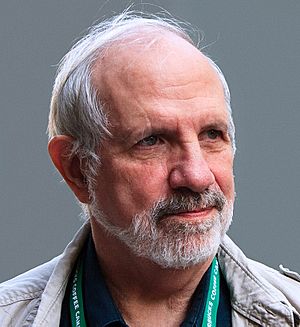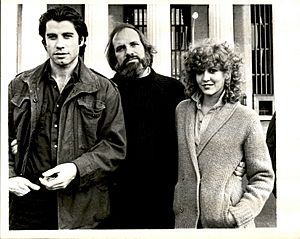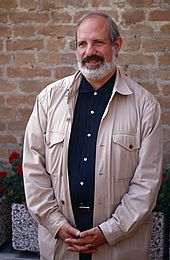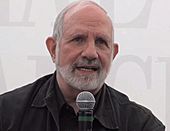Brian De Palma facts for kids
Quick facts for kids
Brian De Palma
|
|
|---|---|

De Palma in 2009
|
|
| Born |
Brian Russell De Palma
September 11, 1940 Newark, New Jersey, U.S.
|
| Alma mater | |
| Occupation |
|
| Years active | 1960–present |
| Spouse(s) |
|
| Children | 2 |
Brian Russell De Palma ([de ˈpalma]; born September 11, 1940) is an American film director and screenwriter. With a career spanning over 50 years, he is best known for work in the suspense, crime and psychological thriller genres. De Palma was a leading member of the New Hollywood generation.
Carrie (1976), his adaptation of Stephen King's novel of the same name, put him on the map. He enjoyed commercial success with Dressed to Kill (1980), The Untouchables (1987) and Mission: Impossible (1996) and made cult classics such as Sisters (1972), Phantom of the Paradise (1974) and The Fury (1978).
As a young director, De Palma dreamed of being the "American Godard". His style is allusive; he paid homage to Alfred Hitchcock in Obsession (1976) and Body Double (1984); Blow Out (1981) is based on Michelangelo Antonioni's Blowup (1966) and Scarface (1983), his remake of Howard Hawks's 1932 film, is dedicated to Hawks and Ben Hecht. ..... In 2015, he was interviewed about his work in a well-received documentary by Noah Baumbach.
Contents
Early life and education
De Palma was born on September 11, 1940, in Newark, New Jersey, the youngest of three boys. His Italian-American parents were Vivienne DePalma (née Muti), and Anthony DePalma, an orthopedic surgeon who was the son of immigrants from Alberona, Province of Foggia. He was raised in Philadelphia, Pennsylvania, and New Hampshire, and attended various Protestant and Quaker schools, eventually graduating from Friends' Central School. He had a poor relationship with his father; this would eventually inspire the teenage character played by Keith Gordon in De Palma's 1980 film Dressed to Kill. When he was in high school, he built computers. He won a regional science-fair prize for a project titled "An Analog Computer to Solve Differential Equations".
Enrolled at Columbia University as a physics student, De Palma became enraptured with the filmmaking process after viewing Citizen Kane and Vertigo. After receiving his undergraduate degree in 1962, De Palma enrolled at the newly coed Sarah Lawrence College as a graduate student in their theater department, earning an M.A. in the discipline in 1964 and becoming one of the first male students among a female population. Once there, influences as various as drama teacher Wilford Leach, the Maysles brothers, Michelangelo Antonioni, Jean-Luc Godard, Andy Warhol, and Alfred Hitchcock impressed upon De Palma the many styles and themes that would shape his own cinema in the coming decades.
Career
1963–1976: Rise to prominence
An early association with a young Robert De Niro resulted in The Wedding Party. The film, which was co-directed with Leach and producer Cynthia Munroe, had been shot in 1963 but remained unreleased until 1969, when De Palma's star had risen sufficiently within the Greenwich Village filmmaking scene. De Niro was unknown at the time; the credits mistakenly display his name as "Robert Denero". The film is noteworthy for its invocation of silent film techniques and an insistence on the jump-cut for effect. De Palma followed this style with various small films for the NAACP and the Treasury Department.
During the 1960s, De Palma began making a living producing documentary films, notably The Responsive Eye, a 1966 movie about The Responsive Eye op-art exhibit curated by William Seitz for MOMA in 1965. In an interview with Joseph Gelmis from 1969, De Palma described the film as "very good and very successful. It's distributed by Pathe Contemporary and makes lots of money. I shot it in four hours, with synched sound. I had two other guys shooting people's reactions to the paintings, and the paintings themselves."
Dionysus in '69 (1969) was De Palma's other major documentary from this period. The film records the Performance Group's performance of Euripides' The Bacchae, starring, amongst others, De Palma regular William Finley. The play is noted for breaking traditional barriers between performers and audience. The film's most striking quality is its extensive use of the split-screen. De Palma recalls that he was "floored" by this performance upon first sight, and in 1973 recounts how he "began to try and figure out a way to capture it on film. I came up with the idea of split-screen, to be able to show the actual audience involvement, to trace the life of the audience and that of the play as they merge in and out of each other."
De Palma's most significant features from this decade are Greetings (1968) and Hi, Mom! (1970). Both films star Robert De Niro and espouse a leftist revolutionary viewpoint common to the era in which they were released. Greetings was entered into the 19th Berlin International Film Festival, where it won a Silver Bear award. His other major film from this period is the slasher comedy Murder a la Mod. Each of these films experiments with narrative and intertextuality, reflecting De Palma's stated intention to become the "American Godard" while integrating several of the themes which permeated Hitchcock's work.
In 1970, De Palma left New York for Hollywood at age thirty to make Get to Know Your Rabbit (1972), starring Orson Welles and Tommy Smothers. Making the film was a crushing experience for De Palma, as Smothers did not like many of De Palma's ideas. Here he made several small, studio and independently-released films that included stand-outs Sisters (1972), Phantom of the Paradise (1974), and Obsession (1976).
1976–1979: Breakthrough
In November 1976, De Palma released a film adaptation of the 1974 novel Carrie by Stephen King. Though some see the psychic thriller as De Palma's bid for a blockbuster, the project was in fact small, underfunded by United Artists, and well under the cultural radar during the early months of production, as the source novel had yet to climb the bestseller list. De Palma gravitated toward the project and changed crucial plot elements based upon his own predilections, not the saleability of the novel. The cast was young and relatively new, though Sissy Spacek and John Travolta had gained attention for previous work in, respectively, film and episodic sitcoms. Carrie became De Palma's first genuine box-office success, garnering Spacek and Piper Laurie Oscar nominations for their performances. Pre-production for the film had coincided with the casting process for George Lucas's Star Wars, and many of the actors cast in De Palma's film had been earmarked as contenders for Lucas's movie, and vice versa. The "shock ending" finale is effective even while it upholds horror-film convention, its suspense sequences are buttressed by teen comedy tropes, and its use of split-screen, split-diopter and slow motion shots tell the story visually rather than through dialogue. As for Lucas' project, De Palma complained in an early viewing of Star Wars that the opening text crawl was poorly written and volunteered to help edit the text to a more concise and engaging form.
The financial and critical success of Carrie allowed De Palma to pursue more personal material. The Demolished Man was a novel that had fascinated De Palma since the late 1950s and appealed to his background in mathematics and avant-garde storytelling. Its unconventional unfolding of plot (exemplified in its mathematical layout of dialogue) and its stress on perception have analogs in De Palma's filmmaking. He sought to adapt it numerous times, though the project would carry a substantial price tag, and has yet to appear on-screen (Steven Spielberg's 2002 adaptation of Philip K. Dick's Minority Report bears striking similarities to De Palma's visual style and some of the themes of The Demolished Man). The result of his experience with adapting The Demolished Man was the 1978 science fiction psychic thriller film The Fury, starring Kirk Douglas, Carrie Snodgress, John Cassavetes and Amy Irving. The film was admired by Jean-Luc Godard, who featured a clip in his mammoth Histoire(s) du cinéma, and Pauline Kael, who championed both The Fury and De Palma. The film boasted a larger budget than Carrie, though the consensus view at the time was that De Palma was repeating himself, with diminishing returns. As a film, it retains De Palma's considerable visual flair, but points more toward his work in mainstream entertainments such as Mission: Impossible, the thematic complex thriller for which he is now better known.
1980–1996: Established career
He directed the neo-noir mystery thriller Blow Out (1981) starring John Travolta, Nancy Allen, and John Lithgow. The film received critical acclaim. The New Yorker film critic Pauline Kael praised the director writing, "De Palma has sprung to the place that Robert Altman achieved with films such as McCabe & Mrs. Miller and Nashville and that Francis Ford Coppola reached with The Godfather films—that is, to the place where genre is transcended and what we're moved by is an artist's vision...it's a great movie. Travolta and Allen are radiant performers". De Palma then directed crime film Scarface (1983) starring Al Pacino and Michelle Pfeiffer with a screenplay by Oliver Stone. The film received mixed reviews with its negative depictions of ethnic stereotypes, as well as its violence. It has since been re-evaluated and became a cult classic. De palma directed the music video for Bruce Springsteen's single "Dancing in the Dark" the same year.
In 1987, De Palma directed the crime film The Untouchables loosely based off the book of the same name, adapted by David Mamet. The film stars Kevin Costner, Andy Garcia, Robert De Niro, and Sean Connery, the later of whom won the Academy Award for Best Supporting Actor for the film. It received critical acclaim and box-office success. De Palma's Vietnam War film Casualties of War (1989) won critical praise but performed poorly in theatres and The Bonfire of the Vanities (1990) was a notorious failure with both critics and audiences. De Palma then had subsequent successes with Raising Cain (1992) and Carlito's Way (1993) with Mission: Impossible (1996) becoming his highest grossing film and starting a successful franchise.
1998–present: Career slump
De Palma's work after Mission: Impossible has been less well received. His ensuing films Snake Eyes (1998), Mission to Mars (2000), and Femme Fatale (2002) all failed at the box office and received generally poor reviews, though Femme Fatale has since been revived in the eyes of many film critics and became a cult classic. His 2006 adaptation of The Black Dahlia was also unsuccessful and is currently the last movie De Palma has directed with backing from Hollywood.
A political controversy erupted over the portrayal of US soldiers in De Palma's 2007 film Redacted. ..... Redacted received a limited release in the United States and grossed less than $1 million against a $5 million budget.
De Palma's output has slowed since the release of Redacted, with subsequent projects often falling into development hell, due mostly to creative differences. In 2012, his film Passion starring Rachel McAdams and Noomi Rapace was selected to compete for the Golden Lion at the 69th Venice International Film Festival but received mixed reviews and was financially unsuccessful.
De Palma's next project was the thriller Domino (2019), released two years after the film began production. It received generally negative reviews and was released direct-to-VOD in the United States, grossing less than half a million dollars internationally. De Palma has also expressed dissatisfaction with both the production of the film and the final result; "I never experienced such a horrible movie set."
In 2018, De Palma published his debut novel in France, Les serpents sont-ils nécessaires? (English translation: Are Snakes Necessary?), co-written with Susan Lehman. It was published in the U.S. in 2020. De Palma and Lehman also wrote a second book, currently unpublished, called Terry, based on one of De Palma's passion projects about a French film production making an adaptation of Thérèse Raquin.
Despite rumors of his supposed retirement after having two projects, Sweet Vengeance and Catch and Kill, fall through, De Palma revealed to Vulture in September 2024 that he had "one other" undisclosed film he was planning to make, and that he was in the process of trying to cast it.
Filmmaking style, techniques and trademarks
De Palma's films can fall into two categories, his thriller films (Sisters, Body Double, Obsession, Dressed to Kill, Blow Out, Raising Cain) and his mainly commercial films ( The Untouchables, Carlito's Way, and Mission: Impossible). He has often produced "De Palma" films one after the other before going on to direct a different genre, but would always return to his familiar territory. Because of the subject matter and graphic violence of some of De Palma's films, such as Dressed to Kill, Scarface and Body Double, they are often at the center of controversy with the Motion Picture Association of America, film critics and the viewing public.
Inspirations
De Palma frequently quotes and references other directors' work. His early work was inspired by the films of Jean-Luc Godard. Michelangelo Antonioni's Blowup and Francis Ford Coppola's The Conversation plots were used for the basis of Blow Out. The Untouchables' finale shoot out in the train station is a clear borrowing from the Odessa Steps sequence in Sergei Eisenstein's The Battleship Potemkin. The main plot from Rear Window was used for Body Double, while it also used elements of Vertigo. Vertigo was also the basis for Obsession. Dressed to Kill was a note-for-note homage to Hitchcock's Psycho, including such moments as the surprise death of the lead actress and the exposition scene by the psychiatrist at the end.
Camera shots
Film critics have often noted De Palma's penchant for unusual camera angles and compositions. He often frames characters against the background using a canted angle shot. Split-screen techniques have been used to show two separate events happening simultaneously. To emphasize the dramatic impact of a certain scene De Palma has employed a 360-degree camera pan. Slow sweeping, panning and tracking shots are often used throughout his films, often through precisely-choreographed long takes lasting for minutes without cutting. Split focus shots, often referred to as "di-opt", are used by De Palma to emphasize the foreground person/object while simultaneously keeping a background person/object in focus. Slow-motion is frequently used in his films to increase suspense.
Personal life
De Palma has been married and divorced three times, to actress Nancy Allen (1979–1983), producer Gale Anne Hurd (1991–1993), and Darnell Gregorio (1995–1997). He has one daughter from his marriage to Hurd, and one daughter from his marriage to Gregorio. He resides in Manhattan, New York.
Filmography
| Year | Title | Distribution |
|---|---|---|
| 1968 | Murder a la Mod | Aries Documentaries |
| Greetings | Sigma III | |
| 1969 | The Wedding Party | Ajay Film Company |
| 1970 | Hi, Mom! | Sigma III |
| 1972 | Get to Know Your Rabbit | Warner Bros. |
| Sisters | American International Pictures | |
| 1974 | Phantom of the Paradise | 20th Century Fox |
| 1976 | Obsession | Columbia Pictures |
| Carrie | United Artists | |
| 1978 | The Fury | 20th Century Fox |
| 1979 | Home Movies | United Artists |
| 1980 | Dressed to Kill | Filmways Pictures |
| 1981 | Blow Out | |
| 1983 | Scarface | Universal Pictures |
| 1984 | Body Double | Columbia Pictures |
| 1986 | Wise Guys | Metro-Goldwyn-Mayer |
| 1987 | The Untouchables | Paramount Pictures |
| 1989 | Casualties of War | Columbia Pictures |
| 1990 | The Bonfire of the Vanities | Warner Bros. |
| 1992 | Raising Cain | Universal Pictures |
| 1993 | Carlito's Way | |
| 1996 | Mission: Impossible | Paramount Pictures |
| 1998 | Snake Eyes | Paramount Pictures Buena Vista International |
| 2000 | Mission to Mars | Buena Vista Pictures Distribution |
| 2002 | Femme Fatale | Warner Bros. |
| 2006 | The Black Dahlia | Universal Pictures |
| 2007 | Redacted | Magnolia Pictures |
| 2012 | Passion | Entertainment One |
| 2019 | Domino | Signature Entertainment |
Awards and nominations
| Year | Title | Academy Awards | BAFTA Awards | Golden Globe Awards | |||
|---|---|---|---|---|---|---|---|
| Nominations | Wins | Nominations | Wins | Nominations | Wins | ||
| 1974 | Phantom of the Paradise | 1 | 1 | ||||
| 1976 | Obsession | 1 | |||||
| Carrie | 2 | 1 | |||||
| 1980 | Dressed to Kill | 1 | |||||
| 1983 | Scarface | 3 | |||||
| 1984 | Body Double | 1 | |||||
| 1987 | The Untouchables | 4 | 1 | 4 | 1 | 2 | 1 |
| 1989 | Casualties of War | 1 | |||||
| 1993 | Carlito's Way | 2 | |||||
| 2006 | The Black Dahlia | 1 | |||||
| Total | 9 | 1 | 4 | 1 | 12 | 1 | |
See also
 In Spanish: Brian De Palma para niños
In Spanish: Brian De Palma para niños




